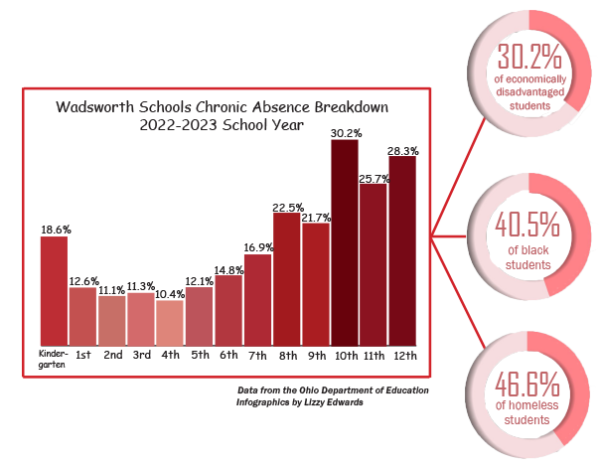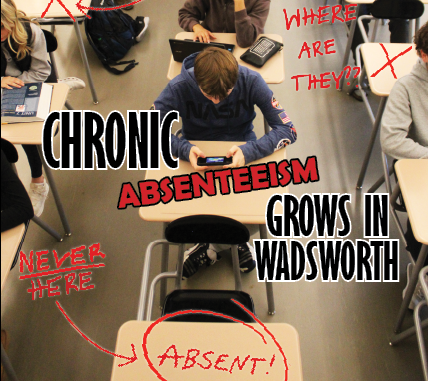Chronic absenteeism is becoming a problem for schools around the country. A student is considered chronically absent when they have missed at least 10% of the school year for any reason.
In Ohio, schools receive annual report cards from the Department of Education that measure how well the school is meeting state education standards. Chronic absenteeism is one of the measurements that contributes to a school’s rating. According to Wadsworth City Schools’ 2022-2023 report card, the chronic absenteeism rate in the district for the past school year was 18.7%.
While chronic absenteeism occurs at all ages throughout the district, it has the highest rates at the high school. As of 2022-2023, all grades at WHS have rates above 20%. Sophomores have the highest rate at 30.2%. Chronic absenteeism generally increases as grade level increases, although kindergarten students have an unusually high rate of 18.6%.
WHS principal Chris Sieber credits the growing awareness of mental health struggles among young adults as one reason for this increase in absences.
“When people are dealing with anxiety or stress or mental health issues, other people don’t see that,” Sieber said. “But I think people have become better attuned to and more understanding of mental health needs.”
It is becoming increasingly common for students to take time off school if they are feeling too stressed and overwhelmed to attend.
“I have parents call me and say, ‘I need to take my kid out of school for a mental health day.’ And I’m like, ‘Okay, I totally get that,’” Sieber said.
Sieber runs a weekly report that shows the percentage of time students are in school and absent. If a student has missed too much school, they will be contacted by the administration in order to find out what is causing these absences.
“We have a process called an Absence Intervention Team, and what we do is we try to work with families and kids about their absences,” Sieber said. “If we have a kid who is chronically absent, we may call an AIT meeting and talk with a teacher or guidance counselor and parents and the student, and we’ll find out what’s going on.”

Sara Kopacko, who is a student mental health coordinator for WHS, has recently become involved in these meetings.
“The goal is to meet with both the student and the parent or guardian to make sure that they’re aware of how much school they’ve missed and to try to figure out what’s going on and how we can get them back to school on a regular basis,” Kopacko said.
Students miss school for a wide variety of reasons, which can be as simple as having a prolonged illness or injury. Some students with poor sleep schedules have low attendance because they have trouble waking up in time for school. Other students deal with more extreme issues like family problems or even homelessness.
“A lot of times there’s some turmoil going on in their lives, and school is just not their priority,” Kopacko said.
The COVID-19 pandemic has likely also played a role in higher rates of student absences. After schools were shut down in the spring of 2020 due to the pandemic, many students have become more accustomed to missing school, especially for illness.
“For a couple of years, it was like if you had the tiniest cough you had to stay home,” Kopacko said. “Sometimes kids are staying home when they’re not feeling great, but they probably could come and get through the day.”
Kopacko works specifically with students who experience mental health struggles related to school.
“For some kids, it’s that they don’t feel connected to school. Sometimes that looks like some mental health challenges or anxiety coming to the building because they don’t feel comfortable, whether it’s they don’t have a set of friends or they haven’t found their niche,” Kopacko said.
The Absence Intervention Team helps make a plan for students who have been chronically absent to get back on track and catch up in their classes. However, missing too much school can cause students to fall behind and feel overwhelmed with the amount of work they need to do.
“Sometimes they miss school because they’re having a hard time. They are not opposed to coming back to school, but they recognize that they’ve been out for so long that they have a mountain of work coming back, and that in and of itself is too much to face,” Kopacko said.
One of the ways Kopacko encourages students to get back on track is to reach out to their teachers for help. If a student communicates with their teachers about what is going on that is causing them to miss school, teachers are usually flexible and willing to work with them.

Mr. Boytim, who teaches Data Science and Quantitative Reasoning, sees how challenging it can be for his students to catch up after missing class.
“Absences are a major issue,” Boytim said. “Not even so much with kids missing a lot of days in a row, but two days a week with illness really adds up. Everything builds, so if you miss an important lab, it’s going to be really hard to do newer labs.”
Boytim utilizes Academic Lab as a time for students to get any extra help they may need.
“I’m available pretty much any day so they can come in and work,” Boytim said.
Brooklyn McCullough, a sophomore at WHS, missed large quantities of school during her freshman year. Like many students, the things going on in her personal life were contributing to her absences.
“It was just the fact that I had a lot going on in my home life, so it was a lot of a struggle just to get [to school],” McCullough said.
During this time, McCullough and her parents received notices from the school that she was truant. After missing so much school, McCullough found it difficult to catch up on her school work, but felt that her teachers were very understanding and helpful.
“It was very difficult to catch up; it took me about two weeks to catch up on one class,” McCullough said. “I just went to different teachers asking for help and making sure I actually understood and wasn’t just doing my own thing.”
Even with the support McCullough has received from teachers, her life situation is still preventing her from attending school regularly.
“It’s much better this year–not as many absences, but still difficult,” McCullough said. “I’m still going through the same stuff since last year.”
Despite the efforts of the administration, absence rates throughout the district are still high. Kopacko feels that helping kids develop a better relationship with school is crucial to bringing down these rates.
“I really believe in getting every kid feeling connected to school,” Kopacko said. “That can happen a bunch of different ways, whether it’s through extracurriculars, friendships, relationships with teachers, or just feeling like this school is [their] school. I think that in and of itself can make a huge difference.”
This story was originally published on Bruin on March 19, 2024.






























![IN THE SPOTLIGHT: Junior Zalie Mann performs “I Love to Cry at Weddings,” an ensemble piece from the fall musical Sweet Charity, to prospective students during the Fine Arts Showcase on Wednesday, Nov. 8. The showcase is a compilation of performances and demonstrations from each fine arts strand offered at McCallum. This show is put on so that prospective students can see if they are interested in joining an academy or major.
Sweet Charity originally ran the weekends of Sept. 28 and Oct. 8, but made a comeback for the Fine Arts Showcase.
“[Being at the front in the spotlight] is my favorite part of the whole dance, so I was super happy to be on stage performing and smiling at the audience,” Mann said.
Mann performed in both the musical theatre performance and dance excerpt “Ethereal,” a contemporary piece choreographed by the new dance director Terrance Carson, in the showcase. With also being a dance ambassador, Mann got to talk about what MAC dance is, her experience and answer any questions the aspiring arts majors and their parents may have.
Caption by Maya Tackett.](https://bestofsno.com/wp-content/uploads/2024/02/53321803427_47cd17fe70_o-1-1200x800.jpg)
![SPREADING THE JOY: Sophomore Chim Becker poses with sophomores Cozbi Sims and Lou Davidson while manning a table at the Hispanic Heritage treat day during lunch of Sept 28. Becker is a part of the students of color alliance, who put together the activity to raise money for their club.
“It [the stand] was really fun because McCallum has a lot of latino kids,” Becker said. “And I think it was nice that I could share the stuff that I usually just have at home with people who have never tried it before.”
Becker recognizes the importance of celebrating Hispanic heritage at Mac.
“I think its important to celebrate,” Becker said. “Because our culture is awesome and super cool, and everybody should be able to learn about other cultures of the world.”
Caption by JoJo Barnard.](https://bestofsno.com/wp-content/uploads/2024/01/53221601352_4127a81c41_o-1200x675.jpg)






